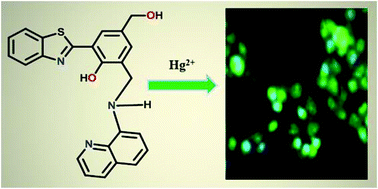A 2-(2′-hydroxyphenyl)benzothiazole (HBT)–quinoline conjugate: a highly specific fluorescent probe for Hg2+ based on ESIPT and its application in bioimaging†
Abstract
A benzothiazole derived chemosensor L has been designed based on the excited-state intramolecular proton transfer (ESIPT) mechanism to afford a fluorescence turn-on response specifically in the presence of Hg2+ ions over a host of biologically relevant metal ions as well as toxic heavy metal ions. The chemosensor exhibits high sensitivity with the detection limit down to 0.11 μM. The metal binding is supported by 1H NMR titrations, ESI-MS spectral analysis and substantiated by theoretical calculations using the density functional theory. The probe shows cell membrane permeability and efficiency for the detection of Hg2+ in HeLa cells.


 Please wait while we load your content...
Please wait while we load your content...